Why Does Car Sputter After Getting Gas?
The loose or missing gas cap is the most common reason for car sputtering after putting gas. The loose or missing gas cap affects the EVAP system. This system controls the fuel vapor coming out. A clogged fuel filter can also cause vehicle hesitating. It blocks the fuel from flowing under right pressure. Also, check for vacuum leaks. These leaks mess up the air-fuel ratio. This causes the vehicle shaking.
Your car might lurch or sputter when you stop at a red light after getting gas. This happens a lot. It’s more than a small problem.
In this guide, I will talk about why your car does this after getting gas. I will also talk about how you can stop this from happening again.
You can also read my guide on car won’t start after getting gas.
- Loose or missing gas cap is the top reason for sputtering after refueling as it affects the EVAP system controlling fuel vapor.
- Stuck EVAP purge valve causes too many vapors to enter the engine, disrupting the air-fuel ratio and making the engine shudder.
- Clogged charcoal canister cannot properly absorb gasoline vapors, leading to engine hestitating.
- Damaged EVAP system hoses prevent proper fuel vapor flow to the engine causing misfires.
- Bad fuel pump unable to supply consistent fuel pressure results in engine shuddering after refueling.
What us My Personal Experience With Car Stalling After Getting Gas?
Once my brother’s old Toyota Camry started sputtering and stalling after he filled up at the gas station. I took a look under the hood and tested the fuel pressure – it was lower than specs.
Knowing the EVAP system can cause issues after refueling, I smoke tested the hoses. Sure enough, I found a cracked vapor hose going to the charcoal canister. After replacing the damaged section of hose, the car ran smoothly again.
It just took some EVAP troubleshooting know-how and a cheap hose replacement to get my brother back on the road.
What Exactly Is EVAP System?
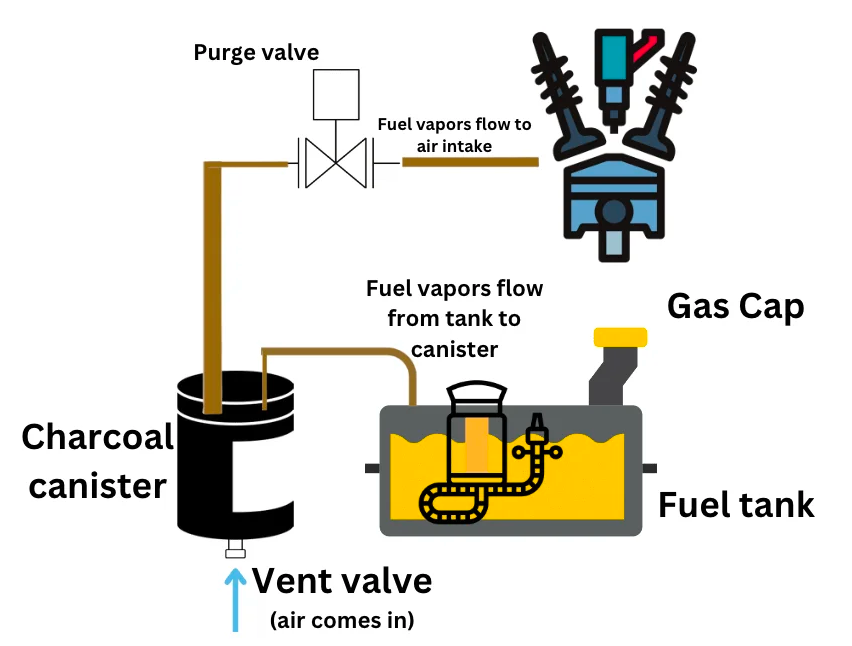
The EVAP system helps stop fuel vapor from going into the air. EVAP means Evaporative Emission Control System. This system catches extra gas fumes from the gas tank. Then it keeps the fumes until the engine can burn them.
The EVAP system has some parts:
- Charcoal canister – This holds the gas vapors.
- Purge valve – This opens to let vapors into the engine.
- Fuel tank pressure sensor – This checks for fuel vapor pressure.
- Vent valve – This lets air into the charcoal canister.
- Gas cap – This seals the gas tank.
Here is how it works:
- Fuel vapors from the tank go into the charcoal canister. The canister traps them.
- When the engine is running, stored fuel vapors get pulled into the engine. The engine burns them with the air-fuel mix.
- The vent valve opens. This pushes vapors out of the canister into the engine.
- The purge valve opens too. This releases the fuel vapors into the engine cylinders.
The vent valve lets fresh air into the tank. This stops too much vacuum pressure in the fuel tank. The vent stays open when driving. It only closes when checking for leaks in EVAP system.
The ECU (Engine Control Unit) receives readings from the fuel pressure sensor. When there are too many fuel vapors, it opens the purge valve. This sends excess vapors to the engine to burn.
What Are the Causes Of Car Shuddering After Gas Refill?
Here are the causes of car sputtering after refiling gas:
1. Gas Cap Is Not Properly Closed
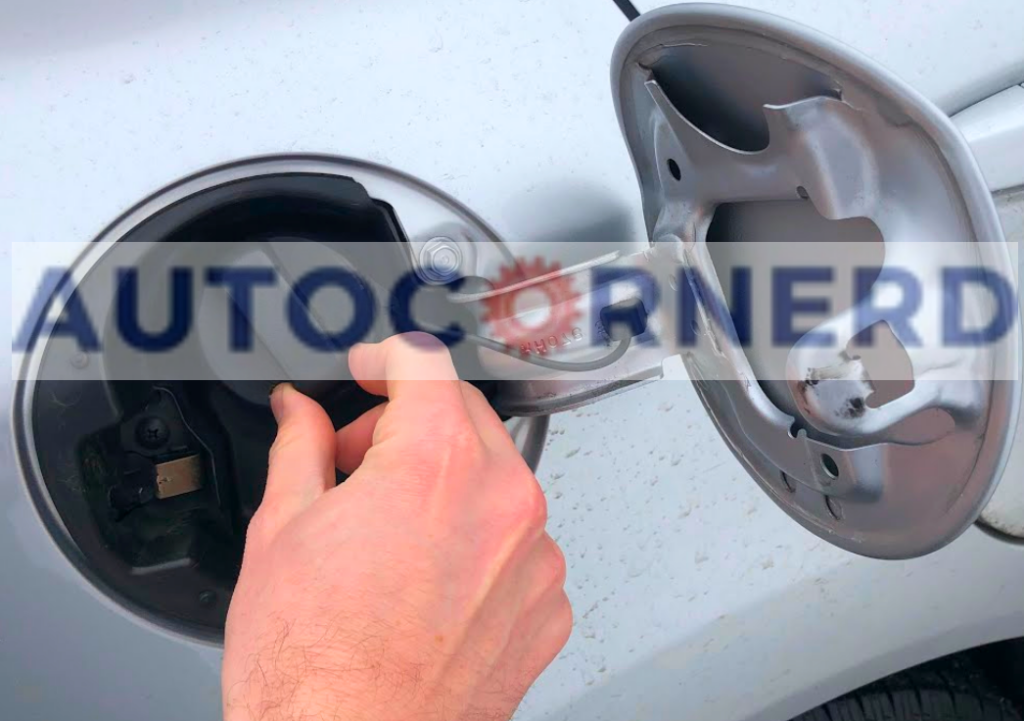
After refueling your car, a loose gas cap is a common problem. Having a loose gas cap seal will cause an EVAP to malfunction. It usually does not cause performance issues in your vehicle but can trigger the check engine light if stays loose.
A check engine light is triggered because the ECU interprets that fuel vapors are leaking out of the fuel tank. This signal is sent by the fuel tank pressure sensor to the ECU.
However, if a gas cap stays loose for a long time, it can cause car to sputter. This is because gas caps are designed to seal the fuel tank, preventing fuel evaporation.
Furthermore, air from the atmosphere can suck into the fuel tank due to the vacuum inside the tank. This in turn affects the air-fuel ratio, leading to a loss of power and vehicle stalling.
How to fix a loose gas cap?
Make sure that the seal of the gas cap is not cracked. You should tighten the gas gap until you hear 3 or 4 clicks.
Also, check if there are deposits of carbon or dirt around the seal of the gas cap or around the fuel filler neck of your vehicle in which a gas cap is tightened.
Before replacing the gas cap, clean any dirt, debris, or rust from around the gas cap and filler neck.
Check that the gas cap seal is not cracked and lightly spray WD-40 on the seal to condition it, without allowing WD-40 to drip.
Also check for rust around the filler neck and lightly sand if needed. Finally, apply a thin coat of silicone grease to the filler neck ring to help the gas cap o-ring make a good seal and prevent leaks. This helps ensure proper fuel system operation.
You should also check if there is rust around the filler neck. If it is, lightly sand it with the sandpaper or steel brush.
2. Stuck EVAP Purge Valve
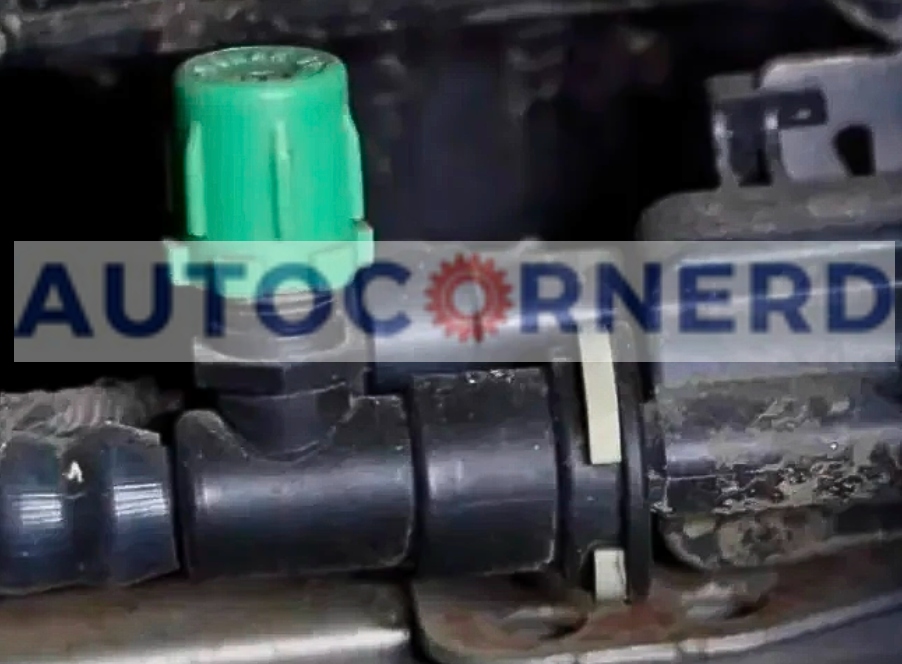
The car engine can sputter or stall after filling up gas. This happens because of a stuck EVAP purge valve. This valve lets fuel vapors from the gas tank into the engine to burn. The EVAP purge valve opens at specific times. It is controlled electronically.
If the EVAP valve stays open, too many vapors enter the engine. This makes the air-fuel mix bad. Then the engine stalls when you stop driving. The EVAP purge valve must open and close at the appropriate time. This prevents excess vapors from building up. Fixing the stuck valve can fix the sputtering problem.
How to know a bad EVAP purge valve?
The purge valve sits next to the throttle body. Or it stays near the fuel tank underneath.
Dirt or debris can get inside the valve. This stops it from opening and closing properly. Issues with the valve’s solenoid can also stick it. The solenoid uses electricity to control the opening and closing. Problems in the solenoid affect the valve’s working.
How to test?
- Turn ignition off
- Locate purge valve. The owner’s manual diagram shows where it is.
- Remove the purge valve.
- Connect a vacuum tester to the valve’s intake manifold port
- If purge valve doesn’t hold the vacuum, it is faulty.
The following video will help you a lot:
3. Blocked Charcoal Canister
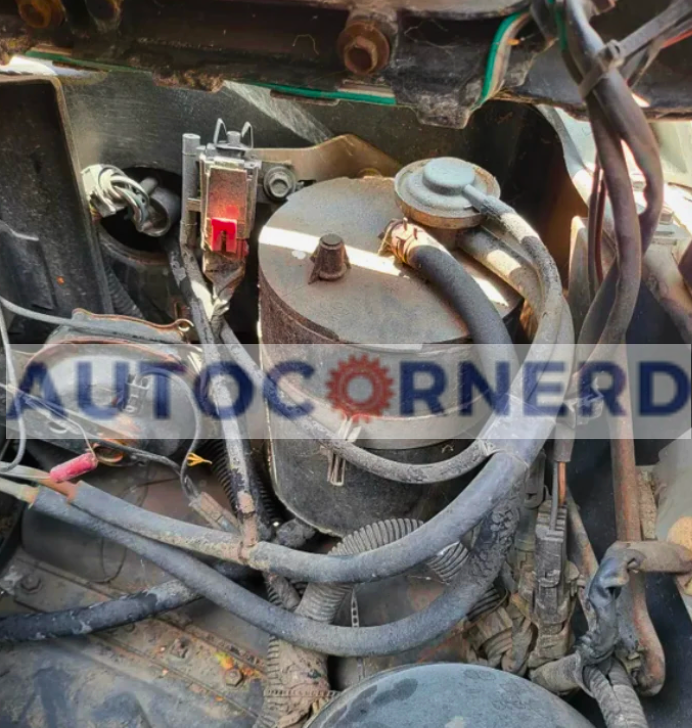
The charcoal holder has activated charcoal. This charcoal absorbs and keeps fuel vapors from the fuel system. The charcoal canister is not made to hold liquid fuel, only vapors.
As the engine runs, extra fuel vapors go into the charcoal canister. They stay there until the engine needs them. When putting in more fuel, vapors that come out also go to the charcoal canister. They wait there before going back to the engine to burn.
Over time, the charcoal bed can get saturated gas if too many vapors go in, like from putting in too much fuel. A saturated charcoal bed cannot properly take in more gasoline vapors.
The charcoal canister must let air pass so the tank can “breathe” as fuel burns. If completely full, no air flows through. This makes uneven pressure in the tank.
This makes the engine stall because the right vapor/air mix gets disrupted. The engine needs a good balance of fuel vapor and air to run smooth.
How to know if the charcoal holder is bad?
Take out the charcoal canister, shake it and see if water, liquid fuel, or loose charcoal bits fall out. If yes, the charcoal holder is broken.
Carefully check the outside with a flashlight for any damage like cracks or leaks. Also check all pipes and connections of the canister for wear like cracking or fraying.
You can also check the charcoal canister by blowing low-pressure air into one opening, and see if air flows out the other opening freely or not.
4. Damaged Vent Valve
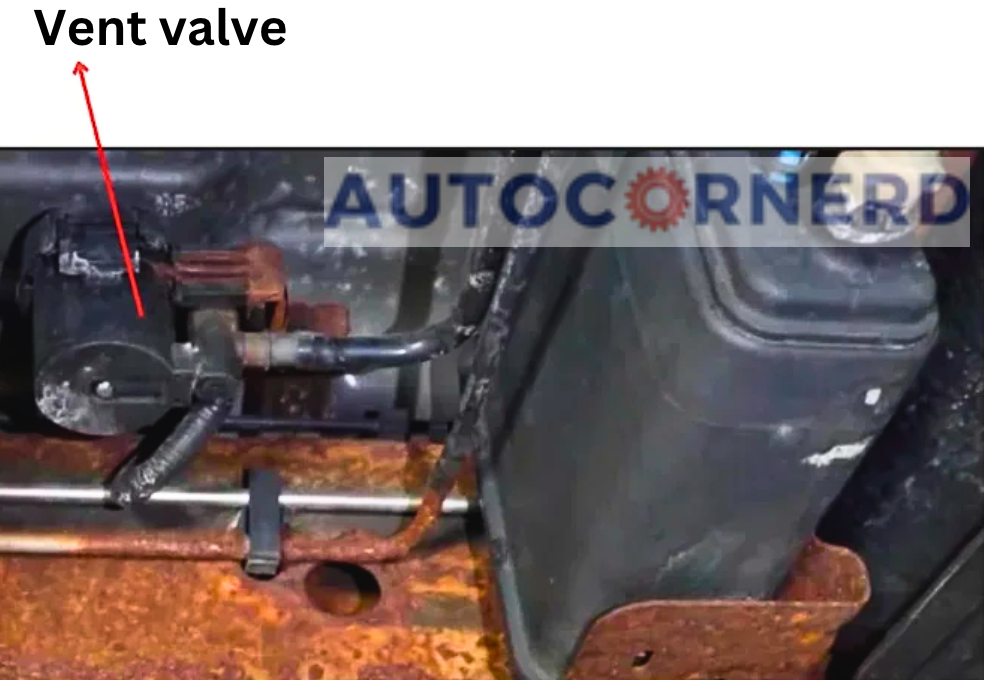
The vent valve has an important job in the EVAP system. It lets air enter the system. This stops too much vacuum pressure inside the fuel tank.
When closed, the vent valve blocks air from coming in the EVAP system. Then there can be too much vacuum pressure. This can make the fuel pump not get enough fuel. So the engine might choke since it does not get fuel properly.
How to check a bad vent valve?
Connect the vent valve to a vacuum pump, just like testing the EVAP purge valve.
If the pump shows no vacuum, the vent valve is good. If it shows pressure, the vent valve is stuck shut.
For the EVAP system to work right, the vent valve must stay open.
5. Kinks or Bends, Crack, Debris in the Fuel Vapor Hoses/Tubes
If the hoses get bent or blocked, the fuel vapors can’t flow properly. For example, a kinked fuel hose stops the flow, so the air-fuel mix in the engine gets disturbed.
Then the engine misfires and stalls. Basically, with blocked hoses, the gas tank struggles to breathe. Replacing damaged vapor hoses often fixes these fill-up issues.
How to find the bad fuel hoses?
Use a UV light under the car to spot cracks in the EVAP hoses. Follow the fuel lines from the engine area back to the gas tank. Any smoke coming out will glow under the UV light.
You might also have a smoke test from a mechanic. They use a smoke machine to pump smoke through the EVAP system to catch leaks.
To check the dirt or debris in the hoses, blow the air through them and see if there is some restriction that requires more force.
5. Bad Fuel Pump
The fuel pump pushes gas from the gas tank to the engine. The engine uses the gas to make power for the car to move.
If the fuel pump is not working right, the car won’t get the gas it needs to make power.
The fuel pump can cause the vehicle to sputter after filling up gas because of “vacuum in the air space”.
When the gas tank can’t “breathe”, the vacuum happens in the air space. This makes the fuel pump not get enough gas.
How to know a bad fuel pump?
Here is how to check the fuel pump:
- Turn the ignition on.
- Open the gas cap.
- If you don’t hear sound from the tank, the fuel pump may not run.
- Now, turn the ignition off.
- If the fuel pump runs, check the gas pressure. Use a fuel pump pressure test kit.
- Find the test port on the fuel line.
- Put the hose of the test kit on the test port.
- If the test gauge shows no gas pressure, the fuel pump needs replacement.
6. Overfilling Of Fuel Tank
The fuel tank needs air inside to work right (more on this later). When you put in too much fuel, the liquid fuel goes into parts it shouldn’t, like EVAP canister, sensors, and solenoids, instead of vapor.
This can make seals stiff, make the engine stall when starting, or even break things. The EVAP system helps keep gas fumes from leaking.
But extra gas makes it fill up instead, then the engine might stall or shake. So you gotta be careful not to top off the tank too high.
How to avoid it?
Gas pumps use a mechanical linkage in the handle to sense the change in suction when gasoline in the tank rises high enough to block the hole.
When the hole is blocked, the higher-pressure air closes a valve and halts the flow of gasoline. This is why the nozzle makes a “clunk” sound when the fuel tank is full.
So, to avoid overfilling, you can keep track of how much fuel goes into the tank, examine the fuel gauge, and remove the nozzle when the safety clicks off at the station.
Moreover, by revving the engine high, you can burn the excessive fuel in the tank, so it’s not overfilled anymore.
Some Of The Common EVAP System OBD2 Codes
- P0440: EVAP System Malfunction
- P0441: EVAP System Incorrect Purge Flow
- P0442: EVAP System Leak Detected (Small)
- P0443: EVAP System Purge Control Valve Circuit
- P0444: EVAP System Purge Control Valve Circuit Open
- P0445: EVAP System Purge Control Valve Circuit Shorted
- P0446: EVAP System Vent Control Circuit Malfunction
- P0447: EVAP System Vent Control Circuit Open
- P0448: EVAP System Vent Control Circuit Shorted
- P0449: EVAP System Vent Valve/Solenoid Circuit Malfunction
- P0450: EVAP System Pressure Sensor Malfunction
- P0451: EVAP System Pressure Sensor Range/Performance
- P0452: EVAP System Pressure Sensor Low Input
- P0453: EVAP System Pressure Sensor High Input
- P0454: EVAP System Pressure Sensor Intermittent
- P0455: EVAP System Leak Detected (Gross Leak)
- P0456: EVAP System Leak Detected (Very Small)
You can use OBD2 scan tool to check if there is any trouble code.
Why Is EVAP System Introduced In Engines?
The EVAP system lets your vehicle’s fuel tank breathe without releasing harmful fuel vapors into the air. Before the EVAP system, fuel tanks had vent holes to manage pressure but allowed fuel vapors to get away, which could make harmful gases.
The need for this breathing is to prevent an issue called cavitation, which can harm the fuel pump. When the fuel pump draws fuel from the tank, it makes a vacuum inside.
If this vacuum isn’t adjusted with air, it makes it difficult for the pump to keep up fuel pressure, potentially starving the engine.
The EVAP system’s vent valve permits air to replace the fuel taken from the tank, keeping the fuel tank pressure steady and preventing engine starvation.
Final Thoughts
In summary, a car shuddering or stalling after getting gas can be incredibly frustrating, but is often caused by a simple issue with the EVAP system.
The most common causes are a loose gas cap, stuck purge valve, blocked charcoal canister, damaged vent valve, kinked hoses, bad fuel pump, or overfilling the tank.
To avoid this issue, be diligent about properly closing the gas cap, inspecting hoses for damage, not overfilling the tank, and addressing any OBD2 codes related to the EVAP system.
With proper maintenance and care taken when refueling, you can prevent those annoying sputters and keep your car running smoothly.
Some First Hand Experiences Shared By Users In Different Communities
Our team conducted research across various online communities, forums, and subreddits to gather user comments and opinions on “car running rough after getting gas”.
User 1 says:
I drive a TLX and had a sputtering problem post-refueling. It was a clogged fuel filter. Noticed a loss of power and rough idling. Changed the filter and it’s been smooth ever since.
User 2 says:
Faced this with my Acadia. The culprit was a faulty fuel pump. The engine struggled for fuel post-refilling. A fuel pressure test confirmed it.
User 3 says:
After refueling, my Tucson started jerking. Took it to the mechanic and found out the purge valve was stuck open, causing vapor buildup in the engine. Replaced it, and it’s running smoothly now.
User 4 says:
I own a Charger, and it started hesitating after I got gas. A diagnostic check showed a faulty EVAP canister. Replacing it resolved the issue. It was a bit pricey but worth it.
User 5 says:
I faced a similar issue with my Ranger. It turned out to be bad fuel injectors. After getting them cleaned, the sputtering stopped. It seems like dirty injectors were the culprit.
